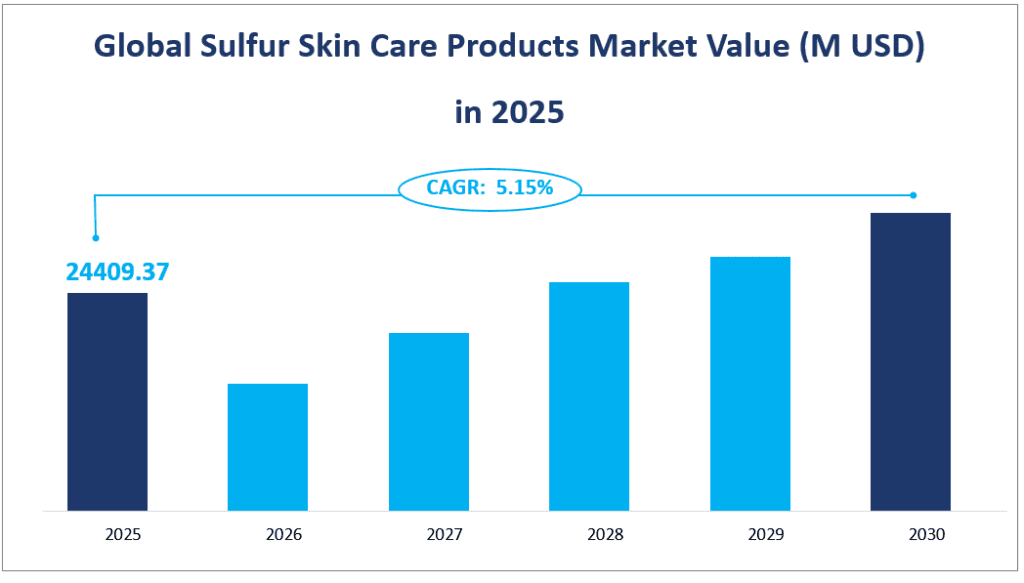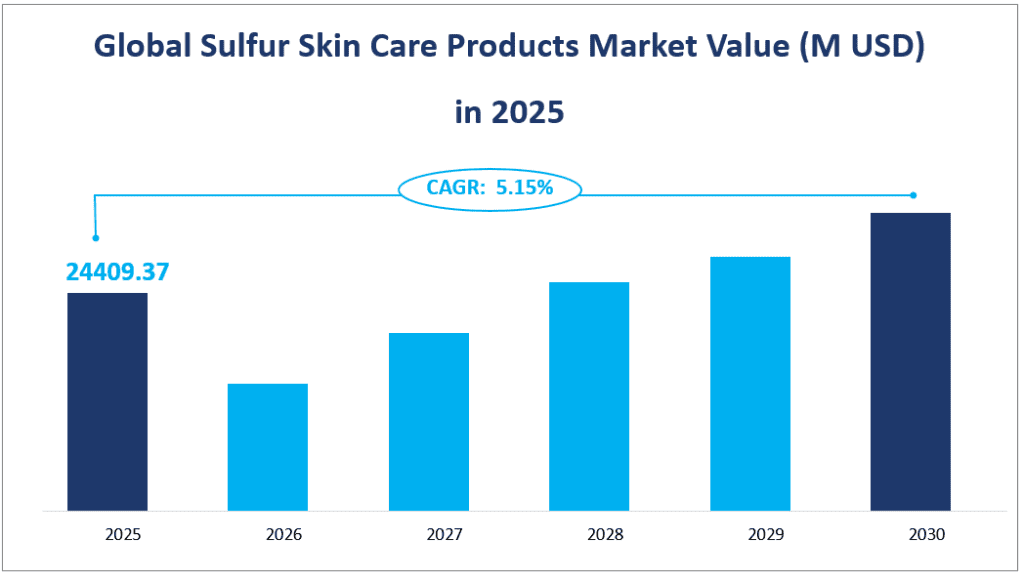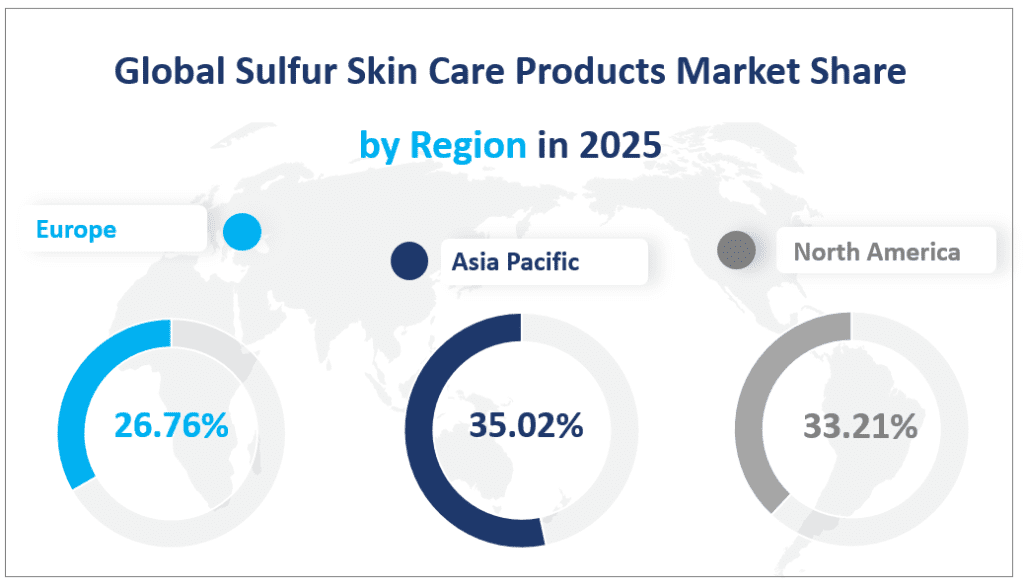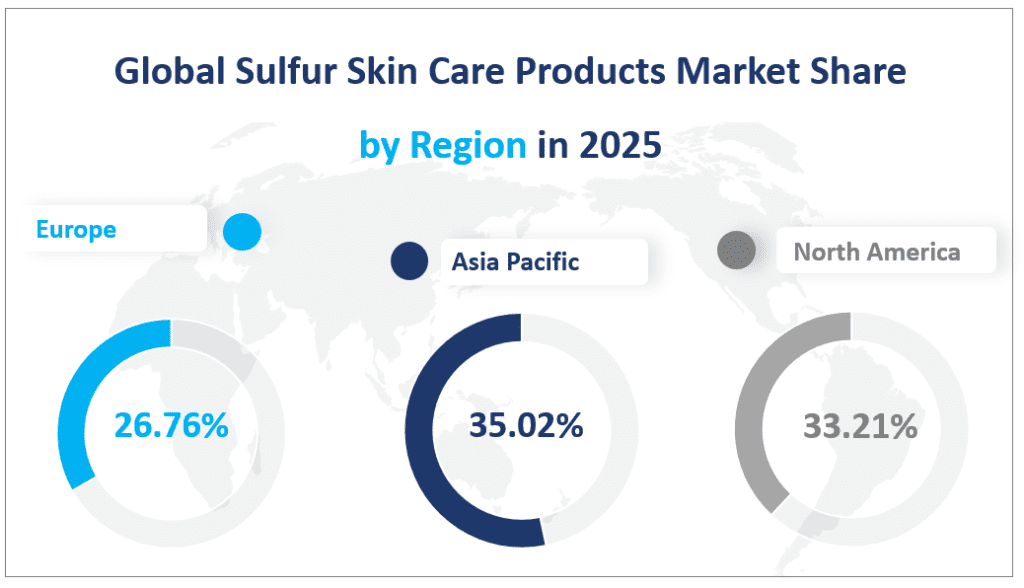1. Global Sulfur Skin Care Products Market Definition
The global Sulfur Skin Care Products market will reach $24,409.37 million in 2025 with a CAGR of 5.15% from 2025 to 2030. This market encompasses a wide range of products designed to address various skin care needs, particularly those related to acne and excess oil production. Sulfur, a key ingredient in these products, is known for its ability to dry out excess sebum and unclog pores, making it highly effective in treating acne and other skin conditions.
Sulfur skin care products market include masks, creams, body care products, and other specialized formulations. These products are designed to target specific skin issues such as acne, oily skin, and dermatitis. The market’s growth is further supported by the increasing awareness of skin health and the rising demand for effective, natural ingredients in personal care products. The use of sulfur in skin care dates back centuries, with its benefits being rediscovered and incorporated into modern formulations. The market is segmented by product type, sales channels, and regional distribution, with North America, Europe, and Asia-Pacific being the key regions driving global demand.
Global Sulfur Skin Care Products Market Value (M USD) in 2025


2. Driving Factors of Sulfur Skin Care Products Market
Several key factors influence the growth of the global Sulfur Skin Care Products market. On one hand, the increasing prevalence of skin issues such as acne and oily skin has led to a higher demand for effective solutions. The rising awareness of skin health and the importance of maintaining a clear complexion has driven consumers to seek out products that deliver tangible results. Additionally, the market benefits from the growing popularity of natural and organic ingredients, with sulfur being a key component in many formulations. The rise of e-commerce has also played a significant role in expanding market reach, making it easier for consumers to access these products globally.
3. Limiting Factors of Sulfur Skin Care Products Market
However, the market also faces certain challenges. One of the primary limiting factors is the potential for sulfur to irritate, especially in individuals with sensitive skin. This has led to concerns about the safety and suitability of sulfur-based products for all skin types. Additionally, the market faces competition from alternative ingredients and formulations that claim similar benefits without the potential side effects. The fluctuating prices of raw materials and rising labor costs also pose challenges for manufacturers, impacting the overall cost structure and pricing of products.
Despite these challenges, the market is expected to continue growing, driven by ongoing innovation and the development of gentler, more effective formulations. Companies are investing in research and development to create products that cater to a wider range of skin types and conditions. The increasing demand from emerging economies, particularly in Asia-Pacific, is also expected to provide a significant boost to the market’s growth in the coming years.
4. Sulfur Skin Care Products Market Segment
Product Types
In 2025, the global Sulfur Skin Care Products market is projected to exhibit diverse revenue contributions from various product types, each with unique market dynamics and growth trajectories. The four primary product types—Masks, Creams, Body Skin Care Products, and Other Products—are expected to collectively generate substantial market revenue, with distinct market shares and growth rates.
Masks are anticipated to achieve a market revenue of $5,509.65 million in 2025. Masks, often used for their quick and effective results in treating acne and excess oil, remain a popular choice among consumers. These products typically contain high concentrations of sulfur, which helps in drying out blemishes and unclogging pores. The market share of Masks is expected to be significant, driven by their convenience and effectiveness in addressing common skin concerns. However, despite their popularity, Masks are projected to have a relatively moderate growth rate compared to other product types.
Creams are poised to dominate the market with a projected revenue of $12,430.73 million in 2025. Creams, which include a wide range of formulations from moisturizers to acne treatments, are versatile and cater to various skin types and conditions. Their ability to provide long-lasting hydration and treatment makes them a staple in many consumers’ skincare routines. Creams are expected to hold the largest market share due to their widespread use and the continuous innovation in product formulations. Additionally, Creams are projected to have a robust growth rate, driven by the increasing demand for multi-functional skincare products that combine sulfur with other beneficial ingredients.
Body Skin Care Products are expected to generate a market revenue of $5,698.60 million in 2025. These products, which include body lotions, creams, and treatments, target larger areas of the body and address issues such as dryness, acne, and eczema. The market share of Body Skin Care Products is substantial, reflecting the growing awareness of overall skin health beyond just the face. The growth rate of this category is steady, supported by the increasing demand for comprehensive skincare solutions that address body-specific concerns.
In summary, Creams are projected to have the largest market share in 2025, driven by their versatility and widespread use. Meanwhile, Other Products are anticipated to have the fastest growth rate, reflecting the trend towards specialized and personalized skincare solutions. The market dynamics of each product type highlight the diverse needs and preferences of consumers, as well as the ongoing innovation within the sulfur skincare industry.
Analysis of Sulfur Skin Care Products Market by Sales Channel
Online Sales are projected to generate a market revenue of $6,236.84 million in 2025. The rapid growth of e-commerce has transformed the way consumers purchase skincare products, with online platforms offering convenience, accessibility, and a wide range of options. The increasing popularity of online shopping, driven by technological advancements and changing consumer preferences, has led to a significant rise in the market share of online sales. This channel is expected to have one of the fastest growth rates, driven by the expansion of digital marketing, social media influence, and the convenience of home delivery.
Offline Sales, which include traditional retail stores, pharmacies, and specialty boutiques, are anticipated to generate a market revenue of $18,172.53 million in 2025. Despite the rise of online shopping, offline sales remain a dominant channel, offering consumers the opportunity to physically interact with products and receive personalized advice from store staff. The offline sales channel is expected to maintain a significant market share, driven by the enduring appeal of in-store experiences and the trust consumers place in established retail brands.
In 2025, the market dynamics of Sulfur Skin Care Products will be significantly influenced by the interplay between online and offline sales channels. While offline sales are expected to hold the largest market share due to their established presence and consumer trust, online sales are poised to experience the fastest growth rate. This growth is driven by the increasing digitalization of retail and the rising consumer preference for the convenience and variety offered by online platforms.
Market Revenue and Share by Segment
| Market Revenue (M USD) in 2025 | Market Share in 2025 | ||
| By Type | Mask | 5509.65 | 22.57% |
| Cream | 12430.73 | 50.93% | |
| Body Skin Care Products | 5698.60 | 23.35% | |
| By Sales Channes | Online | 6236.84 | 25.55% |
| Offline | 18172.53 | 74.45% |
5. Regional Sulfur Skin Care Products Market
North America is anticipated to generate a market revenue of $8,168.53 million in 2025. This region has historically been a dominant player in the skincare industry, driven by high consumer awareness, advanced healthcare infrastructure, and a strong preference for premium skincare products. The United States and Canada, with their robust economies and sophisticated retail environments, contribute significantly to the region’s market share.
Europe, with its diverse and mature skincare market, is projected to achieve a revenue of $6,531.48 million in 2025. European consumers are known for their sophisticated tastes and high standards for skincare products. Countries such as Germany, France, and the UK play a pivotal role in driving the regional market, supported by a strong presence of global skincare brands and a focus on research and development.
Asia-Pacific is expected to be the largest regional market by revenue, generating $8,547.70 million in 2025. This region’s rapid economic growth, increasing urbanization, and rising disposable incomes have significantly contributed to its market expansion. Countries like China, Japan, and South Korea are major drivers, with a growing middle-class population that is increasingly conscious of skincare and wellness. The Asia-Pacific market is also characterized by a strong demand for innovative and technologically advanced skincare products, driven by the region’s technological advancements and a growing interest in natural ingredients.
Latin America is projected to generate a market revenue of $647.78 million in 2025. The region’s market growth is driven by increasing consumer awareness and a growing middle-class population, particularly in countries like Brazil and Mexico. Latin America’s skincare market is characterized by a strong demand for affordable yet effective skincare products, supported by the region’s expanding retail infrastructure and increasing access to global brands.
Middle East & Africa is anticipated to generate a market revenue of $513.88 million in 2025. This region’s market is driven by increasing consumer awareness and a growing demand for skincare products, particularly in countries like Saudi Arabia and the UAE.
Global Sulfur Skin Care Products Market Share by Region in 2025


6. Analysis of the Top 3 Companies in the Sulfur Skin Care Products Market
Company Introduction and Business Overview:
Unilever is a British-Dutch multinational consumer goods company headquartered in London, England, and Rotterdam, Netherlands. Established in 1872, Unilever is one of the world’s largest producers of consumer goods, with a diverse portfolio that includes food, beverages, cleaning agents, and personal care products. The company is renowned for its commitment to sustainability and innovation, with a strong presence in over 190 countries.
Products Offered:
Unilever offers a wide range of Sulfur Skin Care Products market, including medicated soaps, creams, and masks. Their products are designed to address various skin conditions, such as acne, dermatitis, and oily skin. Key brands in this category include Dove and Vaseline, which are well-known for their effectiveness and affordability.
In 2021, Unilever’s revenue from Sulfur Skin Care Products market was $2,851.76 million.
Company Introduction and Business Overview:
L’Oréal, founded in 1909, is a French multinational corporation headquartered in Clichy, Hauts-de-Seine, France. The company is the world’s largest cosmetics and beauty company, with a diverse portfolio that includes hair care, skincare, makeup, and fragrances. L’Oréal is renowned for its commitment to innovation and sustainability, with a strong focus on research and development.
Products Offered:
L’Oréal offers a wide range of Sulfur Skin Care Products market, including masks, creams, and spot treatments. Their products are designed to address various skin conditions, such as acne, oily skin, and dermatitis. Key brands in this category include La Roche-Posay and Vichy, which are well-known for their effectiveness and high-quality formulations.
In 2021, L’Oréal’s revenue from Sulfur Skin Care Products was $2,535.54 million.
Company Introduction and Business Overview:
Estée Lauder Companies Inc., founded in 1946, is a leading manufacturer and marketer of high-quality skincare, makeup, fragrance, and hair care products. Headquartered in New York, USA, the company operates in over 150 countries and territories, with a diverse portfolio of brands that cater to various consumer segments.
Products Offered:
Estée Lauder offers a wide range of Sulfur Skin Care Products, including masks, creams, and spot treatments. Their products are designed to address various skin conditions, such as acne, oily skin, and dermatitis. Key brands in this category include Clinique and Origins, which are well-known for their effectiveness and high-quality formulations.
In 2021, Estée Lauder’s revenue from Sulfur Skin Care Products was $1,463.90 million.
Major Players
| Company Name | Headquarters | Sales Regions |
| Unilever | UK | Worldwide |
| L’Oréal | France | Worldwide |
| Estée Lauder | US | Worldwide |
| KOSE | Japan | Mainly in Asia-Pacific |
| Peter Thomas Roth Clinical Skin Care | US | Mainly in America, Europe |
| Mario Badescu | US | Mainly in North America |
| Sunday Riley | US | Mainly in North America, Europe |
| Dr. Dennis Gross Skincare | US | Mainly in North America |
| Grisi | Mexico | Mainly in North America |
| Dr. Robaina | US | Mainly in North America |
| Sulfur8 | US | Mainly in North America |
| OVANTE | US | Mainly in North America |
| CutiCare Products | US | Mainly in North America |
| Jason | US | Worldwide |
1 SULFUR SKIN CARE PRODUCTS MARKET OVERVIEW
1.1 Product Overview and Scope of Sulfur Skin Care Products
1.2 Sulfur Skin Care Products Segment by Type
1.2.1 Global Sulfur Skin Care Products Revenue Growth Rate Comparison by Type (2021-2027)
1.2.2 Mask
1.2.3 Cream
1.2.4 Body Skin Care Products
1.3 Sulfur Skin Care Products Segment by Sales Channel
1.3.1 Global Sulfur Skin Care Products Sales Comparison by Sales Channel (2021-2027)
1.3.2 Online
1.3.3 Offline
1.4 Global Sulfur Skin Care Products Market Size Estimates and Forecasts
1.4.1 Global Sulfur Skin Care Products Revenue 2016-2027
1.4.2 Global Sulfur Skin Care Products Sales 2016-2027
1.4.3 Sulfur Skin Care Products Market Size by Region: 2016 Versus 2021 Versus 2027
2 SULFUR SKIN CARE PRODUCTS MARKET COMPETITION BY MANUFACTURERS
2.1 Global Sulfur Skin Care Products Sales Market Share by Manufacturers (2016-2021)
2.2 Global Sulfur Skin Care Products Revenue Market Share by Manufacturers (2016-2021)
2.3 Global Sulfur Skin Care Products Average Price by Manufacturers (2016-2021)
2.4 Manufacturers Sulfur Skin Care Products Manufacturing Sites, Area Served
2.5 Sulfur Skin Care Products Market Competitive Situation and Trends
2.5.1 Sulfur Skin Care Products Market Concentration Rate
2.5.2 The Global 5 Largest Sulfur Skin Care Products Players Market Share by Revenue
2.5.3 Global Sulfur Skin Care Products Market Share by Company Type (Tier 1, Tier 2, and Tier 3)
2.6 Manufacturers Mergers & Acquisitions, Expansion Plans
3 SULFUR SKIN CARE PRODUCTS RETROSPECTIVE MARKET SCENARIO BY REGION
3.1 Global Sulfur Skin Care Products Retrospective Market Scenario in Sales by Region: 2016-2021
3.2 Global Sulfur Skin Care Products Retrospective Market Scenario in Revenue by Region: 2016-2021
3.3 North America Sulfur Skin Care Products Market Facts & Figures by Country
3.3.1 North America Sulfur Skin Care Products Sales by Country
3.3.2 North America Sulfur Skin Care Products Revenue by Country
3.3.3 U.S.
3.3.4 Canada
3.4 Europe Sulfur Skin Care Products Market Facts & Figures by Country
3.4.1 Europe Sulfur Skin Care Products Sales by Country
3.4.2 Europe Sulfur Skin Care Products Revenue by Country
3.4.3 Germany
3.4.4 France
3.4.5 U.K.
3.4.6 Italy
3.4.7 Russia
3.5 Asia Pacific Sulfur Skin Care Products Market Facts & Figures by Region
3.5.1 Asia Pacific Sulfur Skin Care Products Sales by Region
3.5.2 Asia Pacific Sulfur Skin Care Products Revenue by Region
3.5.3 China
3.5.4 Japan
3.5.5 South Korea
3.5.6 India
3.5.7 Australia
3.5.8 Taiwan
3.5.9 Indonesia
3.5.10 Thailand
3.5.11 Malaysia
3.5.12 Philippines
3.6 Latin America Sulfur Skin Care Products Market Facts & Figures by Country
3.6.1 Latin America Sulfur Skin Care Products Sales by Country
3.6.2 Latin America Sulfur Skin Care Products Revenue by Country
3.6.3 Mexico
3.6.4 Brazil
3.6.5 Argentina
3.7 Middle East and Africa Sulfur Skin Care Products Market Facts & Figures by Country
3.7.1 Middle East and Africa Sulfur Skin Care Products Sales by Country
3.7.2 Middle East and Africa Sulfur Skin Care Products Revenue by Country
3.7.3 Turkey
3.7.4 Saudi Arabia
3.7.5 U.A.E
4 SULFUR SKIN CARE PRODUCTS HISTORIC MARKET ANALYSIS BY TYPE
4.1 Global Sulfur Skin Care Products Sales Market Share by Type (2016-2021)
4.2 Global Sulfur Skin Care Products Revenue Market Share by Type (2016-2021)
4.3 Global Sulfur Skin Care Products Price by Type (2016-2021)
5 SULFUR SKIN CARE PRODUCTS HISTORIC MARKET ANALYSIS BY SALES CHANNEL
5.1 Global Sulfur Skin Care Products Sales Market Share by Sales Channel (2016-2021)
5.2 Global Sulfur Skin Care Products Revenue Market Share by Sales Channel (2016-2021)
5.3 Global Sulfur Skin Care Products Price by Sales Channel (2016-2021)
6 KEY COMPANIES PROFILED
6.1 Unilever
6.1.1 Unilever Corporation Information
6.1.2 Unilever Description and Business Overview
6.1.3 Unilever Sulfur Skin Care Products Sales, Revenue and Gross Margin (2016-2021)
6.1.4 Unilever Sulfur Skin Care Products Product Portfolio
6.2 L’Oréal
6.2.1 L’Oréal Corporation Information
6.2.2 L’Oréal Description and Business Overview
6.2.3 L’Oréal Sulfur Skin Care Products Sales, Revenue and Gross Margin (2016-2021)
6.2.4 L’Oréal Sulfur Skin Care Products Product Portfolio
6.3 Estee Lauder
6.3.1 Estee Lauder Corporation Information
6.3.2 Estee Lauder Description and Business Overview
6.3.3 Estee Lauder Sulfur Skin Care Products Sales, Revenue and Gross Margin (2016-2021)
6.3.4 Estee Lauder Sulfur Skin Care Products Product Portfolio
6.4 KOSE
6.4.1 KOSE Corporation Information
6.4.2 KOSE Description and Business Overview
6.4.3 KOSE Sulfur Skin Care Products Sales, Revenue and Gross Margin (2016-2021)
6.4.4 KOSE Sulfur Skin Care Products Product Portfolio
6.5 Peter Thomas Roth Clinical Skin Care
6.5.1 Peter Thomas Roth Clinical Skin Care Corporation Information
6.5.2 Peter Thomas Roth Clinical Skin Care Description and Business Overview
6.5.3 Peter Thomas Roth Clinical Skin Care Sulfur Skin Care Products Sales, Revenue and Gross Margin (2016-2021)
6.5.4 Peter Thomas Roth Clinical Skin Care Sulfur Skin Care Products Product Portfolio
6.6 Mario Badescu
6.6.1 Mario Badescu Corporation Information
6.6.2 Mario Badescu Description and Business Overview
6.6.3 Mario Badescu Sulfur Skin Care Products Sales, Revenue and Gross Margin (2016-2021)
6.6.4 Mario Badescu Sulfur Skin Care Products Product Portfolio
6.7 Sunday Riley
6.7.1 Sunday Riley Corporation Information
6.7.2 Sunday Riley Description and Business Overview
6.7.3 Sunday Riley Sulfur Skin Care Products Sales, Revenue and Gross Margin (2016-2021)
6.7.4 Sunday Riley Sulfur Skin Care Products Product Portfolio
6.8 Dr. Dennis Gross Skincare
6.8.1 Dr. Dennis Gross Skincare Corporation Information
6.8.2 Dr. Dennis Gross Skincare Description and Business Overview
6.8.3 Dr. Dennis Gross Skincare Sulfur Skin Care Products Sales, Revenue and Gross Margin (2016-2021)
6.8.4 Dr. Dennis Gross Skincare Sulfur Skin Care Products Product Portfolio
6.9 Grisi
6.9.1 Grisi Corporation Information
6.9.2 Grisi Description and Business Overview
6.9.3 Grisi Sulfur Skin Care Products Sales, Revenue and Gross Margin (2016-2021)
6.9.4 Grisi Sulfur Skin Care Products Product Portfolio
6.10 Dr. Robaina
6.10.1 Dr. Robaina Corporation Information
6.10.2 Dr. Robaina Description and Business Overview
6.10.3 Dr. Robaina Sulfur Skin Care Products Sales, Revenue and Gross Margin (2016-2021)
6.10.4 Dr. Robaina Sulfur Skin Care Products Product Portfolio
6.11 Sulfur8
6.11.1 Sulfur8 Corporation Information
6.11.2 Sulfur8 Description and Business Overview
6.11.3 Sulfur8 Sulfur Skin Care Products Sales, Revenue and Gross Margin (2016-2021)
6.11.4 Sulfur8 Sulfur Skin Care Products Product Portfolio
6.12 OVANTE
6.12.1 OVANTE Corporation Information
6.12.2 OVANTE Description and Business Overview
6.12.3 OVANTE Sulfur Skin Care Products Sales, Revenue and Gross Margin (2016-2021)
6.12.4 OVANTE Sulfur Skin Care Products Product Portfolio
6.13 CutiCare Products
6.13.1 CutiCare Products Corporation Information
6.13.2 CutiCare Products Description and Business Overview
6.13.3 CutiCare Products Sulfur Skin Care Products Sales, Revenue and Gross Margin (2016-2021)
6.13.4 CutiCare Products Sulfur Skin Care Products Product Portfolio
6.14 Jason
6.14.1 Jason Corporation Information
6.14.2 Jason Description and Business Overview
6.14.3 Jason Sulfur Skin Care Products Sales, Revenue and Gross Margin (2016-2021)
6.14.4 Jason Sulfur Skin Care Products Product Portfolio
7 SULFUR SKIN CARE PRODUCTS MANUFACTURING COST ANALYSIS
7.1 Sulfur Skin Care Products Key Raw Materials Analysis
7.1.1 Key Raw Materials
7.1.2 Key Suppliers of Raw Materials
7.2 Proportion of Manufacturing Cost Structure
7.3 Manufacturing Process Analysis of Sulfur Skin Care Products
7.4 Sulfur Skin Care Products Industrial Chain Analysis
8 MARKETING CHANNEL, DISTRIBUTORS AND CUSTOMERS
8.1 Marketing Channel
8.2 Sulfur Skin Care Products Distributors List
9 SULFUR SKIN CARE PRODUCTS MARKET DYNAMICS
9.1 Sulfur Skin Care Products Industry Trends
9.2 Sulfur Skin Care Products Growth Drivers
9.3 Sulfur Skin Care Products Market Challenges and Restraints
9.4 Sulfur Skin Care Products Market Opportunity
10 GLOBAL MARKET FORECAST
10.1 Sulfur Skin Care Products Market Estimates and Projections by Type
10.1.1 Global Forecasted Sales of Sulfur Skin Care Products by Type (2022-2027)
10.1.2 Global Forecasted Revenue of Sulfur Skin Care Products by Type (2022-2027)
10.2 Sulfur Skin Care Products Market Estimates and Projections by Sales Channel
10.2.1 Global Forecasted Sales of Sulfur Skin Care Products by Sales Channel (2022-2027)
10.2.2 Global Forecasted Revenue of Sulfur Skin Care Products by Sales Channel (2022-2027)
10.3 Sulfur Skin Care Products Market Estimates and Projections by Region
10.3.1 Global Forecasted Sales of Sulfur Skin Care Products by Region (2022-2027)
10.3.2 Global Forecasted Revenue of Sulfur Skin Care Products by Region (2022-2027)
11 RESEARCH FINDINGS AND CONCLUSION
12 Appendix
12.1 Methodology
12.2 Research Data Source
